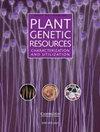印度东北地区辣椒地方品种对炭疽病(辣椒炭疽病和辣椒炭疽病)抗性评价
IF 0.7
4区 生物学
Q3 PLANT SCIENCES
Plant Genetic Resources: Characterization and Utilization
Pub Date : 2022-03-25
DOI:10.1017/s1479262121000666
引用次数: 1
摘要
炭疽菌引起的炭疽病或果腐病在世界辣椒生产中造成了巨大的经济损失。本研究收集了来自印度东北部地区的24个不同的Bhut Jolokia辣椒地方品种和7个辣椒品种,并在体外和体内条件下对辣椒炭疽菌和C. gloeosporioides感染进行了筛选。在田间鉴定中,8个辣椒基因型(CC0164、CC0165、CC0191、CC0192、CC0202、CC0206、CC0209和CC0218)对辣椒病具有高抗性,12个基因型(CC0154、CC0179、CC0181、CC0183、CC0186、CC0189、CC0193、CC0198、CC0205、CC0210、CC0213和CC0217)对辣椒病具有抗性。在离体种质评价中,分别有11个和12个地方品种对辣椒红霉和gloeosporioides具有高抗性。根据研究结果,大多数Bhut Jolokia辣椒地方品种对炭疽病具有抗性。鉴于农民因过度使用杀菌剂和杀虫剂而遇到的困难,已经开始进行寄主抗性的种质筛选。在目前的研究中发现的抗性品系为解决炭疽病提供了更好的选择,并且可以有效地用于培育抗炭疽病品种的育种计划。本文章由计算机程序翻译,如有差异,请以英文原文为准。
Evaluation of resistance against anthracnose (Colletotrichum capsici and C. gloeosporioides) in chilli landraces collected from the northeastern region of India
Anthracnose or fruit rot disease caused by Colletotrichum spp. leads to substantial economic losses in chilli (Capsicum annuum L.) production worldwide. In the present study, 24 different Bhut Jolokia chilli landraces and seven Capsicum annuum cultivars have been collected from the northeastern region of India and subsequently screened under in vitro and in vivo conditions against Colletotrichum capsici and C. gloeosporiodes infections. During field evaluation, eight chilli genotypes (CC0164, CC0165, CC0191, CC0192, CC0202, CC0206, CC0209 and CC0218) were highly resistant and 12 genotypes (CC0154, CC0179, CC0181, CC0183, CC0186, CC0189, CC0193, CC0198, CC0205, CC0210, CC0213 and CC0217) were found in resistant category against C. capsici infection. During in-vitro germplasm evaluation, 11 and 12 landraces were found to be highly resistant to C. capsici and C. gloeosporioides infections, respectively. According to the findings, the majority of Bhut Jolokia chilli landraces are resistant to anthracnose. Given the difficulties farmers experience as a result of excessive use of fungicides and pesticides, germplasm screening for host resistance has already begun. The resistant lines identified in the current study offers better choices to tackle anthracnose and could be used effectively in breeding programs to develop anthracnose resistant varieties.
求助全文
通过发布文献求助,成功后即可免费获取论文全文。
去求助
来源期刊

Plant Genetic Resources: Characterization and Utilization
Agricultural and Biological Sciences-Agronomy and Crop Science
CiteScore
2.80
自引率
0.00%
发文量
29
审稿时长
>12 weeks
期刊介绍:
Plant Genetic Resources is an international journal which provides a forum for describing the application of novel genomic technologies, as well as their integration with established techniques, towards the understanding of the genetic variation captured in both in situ and ex situ collections of crop and non-crop plants; and for the airing of wider issues relevant to plant germplasm conservation and utilisation. We particularly welcome multi-disciplinary approaches that incorporate both a technical and a socio-economic focus. Technical aspects can cover developments in technologies of potential or demonstrated relevance to the analysis of variation and diversity at the phenotypic and genotypic levels.
 求助内容:
求助内容: 应助结果提醒方式:
应助结果提醒方式:


